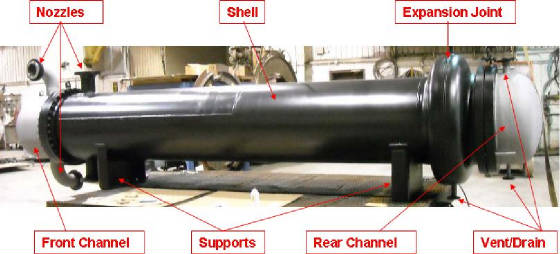Shell & Tube Heat Exchangers
Shell-and-Tube Heat Exchangers Construction Details
The shell-and-tube heat exchanger is named for its two major components – round tubes mounted inside a cylindrical shell.
The shell cylinder can be fabricated from rolled plate or from piping (up to 24 inch diameters). The tubes are thin-walled tubing produced specifically for use in heat exchangers.
Other components include: the channels (heads), tubesheets, baffles, tie rods & spacers, pass partition plates and expansion joint (when required). Shell & tube heat exchanger designs and constructions are governed by the TEMA and ASME codes.
|
|||||||||
|
|
|||||||||
Shell & Tube Heat Exchangers Tubes : –
Tubing may be seamless or welded. Seamless tubing is produced in an extrusion process; welded tubing is produced by rolling a strip into a cylinder and welding the seam. Welded tubing is usually more economical.
Normal tube diameters are 5/8 inch, 3/4 inch and 1 inch. Tubes of smaller diameter can be used but they are more difficult to clean mechanically. Tubes of larger diameter are sometimes used either to facilitate mechanical cleaning or to achieve lower pressure drop.
The normal tube wall thickness ranges from 12 to 16 BWG (from 0.109 inches to 0.065 inches thick). Tubes with thinner walls (18 to 20 BWG) are used when the tubing material is relatively expensive such as titanium.
Tubing may be finned to provide more heat transfer surface; finning is more common on the outside of the tubes, but is also available on the inside of the tubes. High flux tubes are tubing with special surface to enhance heat transfer on either or both sides of the tube wall. Inserts such as twisted tapes can be installed inside tubes to improve heat transfer especially when handling viscous fluids in laminar flow conditions. Twisted tubes are also available. These tubes can provide enhanced heat transfer in certain applications.
- Large heat transfer area in a small volume
- Heat transfer rates to 3,500,000 BTU/hr (1025 kW)
- Liquid flows to 160 GPM (605 LPM)
- Pressures up to 1,500 psi (104 bar)
- 316L SS, Hastelloy®, Inconel®, Titanium and other alloys
- Nickel brazed (no welds)
- NPT, tube stub, or custom fittings
- Mounting kits available
- Every unit pressure tested
- Maintenance free
- Processing equipment
- Condensing and evaporating
- Regenerative heat transfer
- Process fluid temperature control
- Batch process cooling or heating
- Cryogenic cooling
- Sample cooling
